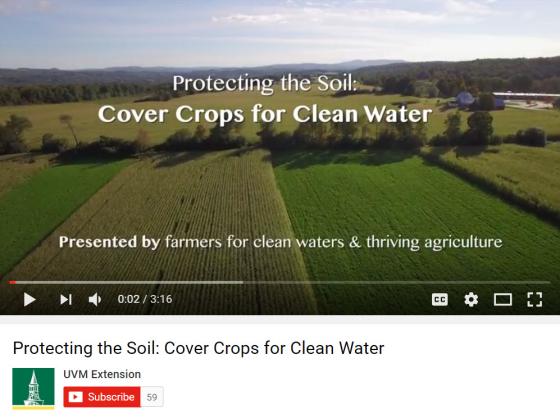Posted February 22, 2017 at 10:51am by Laura Hardie
New Video Features Farmer Contributions to Healthy Soil and Clean Water

To help the public better understand the benefits of cover crops and other environmentally friendly farming practices, three Vermont farmer watershed protection groups have partnered to produce a short video.
The video, Protecting the Soil: Cover Crops for Clean Water, was developed by the Champlain Valley Farmer Coalition (CVFC), Connecticut River Watershed Farmers Alliance (CRWFA) and Farmer's Watershed Alliance (FWA) in cooperation with University of Vermont (UVM) Extension. The video features Vermont agronomists and farmers discussing strategies for using winter cover crops to help protect Lake Champlain and other state waterways.
"Cover crops are planted after the farmer's main crop, such as corn, is harvested in the fall," explained Brian Kemp, CVFC president. "They grow throughout the winter and spring to build soil health and are widely recognized as an environmentally sustainable way for farmers to prevent nutrients and sediment from leaving the fields."
According to the U.S. Department of Agriculture's Natural Resources Conservation Service (NRCS) data, Vermont farmers planted a record-setting 25,727 acres of cover crops on more than 2,000 fields in 2016 on approximately 25 percent of all annual cropland in Vermont. That's a 58 percent increase in the acres of protective winter cover crops planted in 2015, according to NRCS.
These included a diversity of plant species such as winter cereal rye, annual ryegrass, oats, clover, vetch and even radish and turnip. NRCS provides technical and financial assistance to help farmers plant cover crops and tracks the acres planted. However, many farmers in Vermont plant cover crops on their own, without any assistance, so the acres planted may be even greater.
FWA has documented acreage planted in cover crops on farms in Franklin and Grand Isle Counties since the group was established in 2006. In 2016 a total of 10,155 acres of cover crops were planted on these farms.
CVFC was established in 2013 and includes farmers in Addison, Chittenden and Rutland Counties. They planted 9,100 acres of cover crops last year, an increase of more than 30 percent compared to 2015. CRWFA, which just organized in 2016 and represents farmers in seven Vermont and New Hampshire counties, expects to have similar data to report starting in 2017.
"The adoption of cover crops in Vermont has been extremely rapid over the past couple years," said Heather Darby, UVM Extension agronomist and FWA treasurer. "Farmers are thinking about their soils in new and innovative ways because they understand the environmental and agronomic benefits to improve the soil, control erosion and protect our waterways."
Cover crops also are helping farmers to meet goals recently outlined by the U.S. Environmental Protection Agency (EPA) to protect and restore the waters of Lake Champlain. In 2016 EPA established new phosphorus Total Maximum Daily Load (TMDLs) for Lake Champlain to reduce nutrient run-off. The TMDLs were developed in collaboration with the Vermont Agency of Natural Resources Department of Environmental Conservation and the Vermont Agency of Agriculture, Food and Markets.
One way Vermont farmers have responded is by increasing acreage protected by cover crops to prevent nutrients from leaving their fields. UVM Extension estimates that the 25,727 acres of cover crops planted last year will prevent an estimated 28,000 tons of topsoil from leaving fields as erosion. Additionally, an estimated 51 tons of phosphorus was conserved in the cover crop plants and is available to feed the next crop to be grown.
Cover crops are just one of many conservation practices farmers use to protect soil and water quality. There are many resources available to farmers interested in learning more about environmentally friendly practices including cover crops. UVM Extension, NRCS and the Vermont Agency of Agriculture all have technical and/or financial resources available.
##
About Champlain Valley Farmer Coalition:
Champlain Valley Farmer Coalition is a nonprofit corporation made up of Vermont farmers of all kinds (dairy, beef, field crops, vegetables) and supporting organizations and individuals. They are committed to working together to protect water quality in Lake Champlain and to support a thriving agricultural economy in Vermont. With more than 80 members that include farmers, agricultural businesses and support organizations, they demonstrate the many ways farms can accomplish both goals and share that with other farmers, the public and policy makers.
About Connecticut River Watershed Farmers Alliance:
The Connecticut River Farmers Watershed Alliance is committed and dedicated to preserving the quality of our environment while maintaining a strong agricultural sector for the economic and social benefit of the region.The economic viability of agriculture in the Connecticut River Watershed is dependent upon environmental practices that improve the soil, air and water quality. We encourage all sectors of agriculture as well as municipalities and others to join in recognizing our shared responsibility to sustain the environmental health of the watershed area.
About Farmers’ Watershed Alliance:
The Franklin and Grand Isle Farmers’ Watershed Alliance mission is to ensure environmentally positive solutions and enable the dairy industry through education and funding to better the soil, air, and water of the Lake Champlain Watershed while remaining economically viable. Secondly to promote and defend dairy farming to further its future as one of the largest contributors to the state's economy. FWA has connected and assisted over 200 dairy farms throughout Franklin & Grand Isle Counties to protect water quality.
